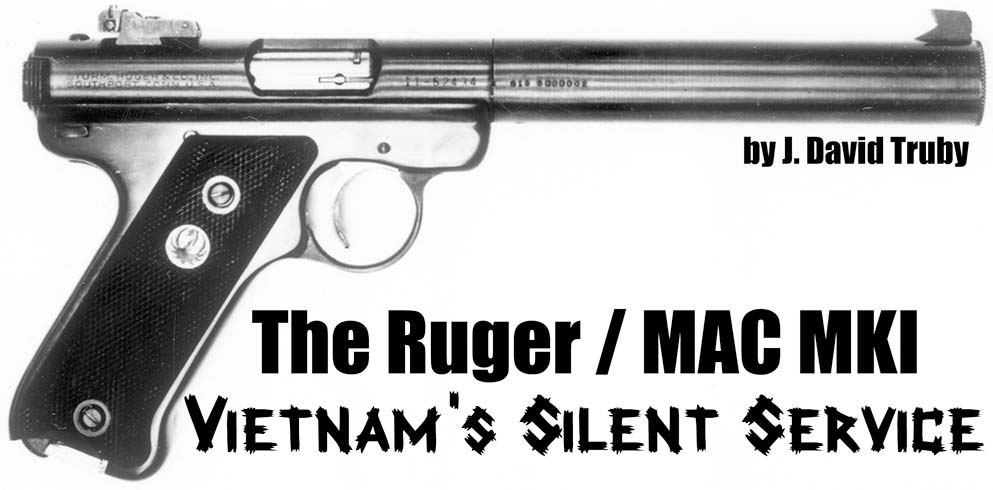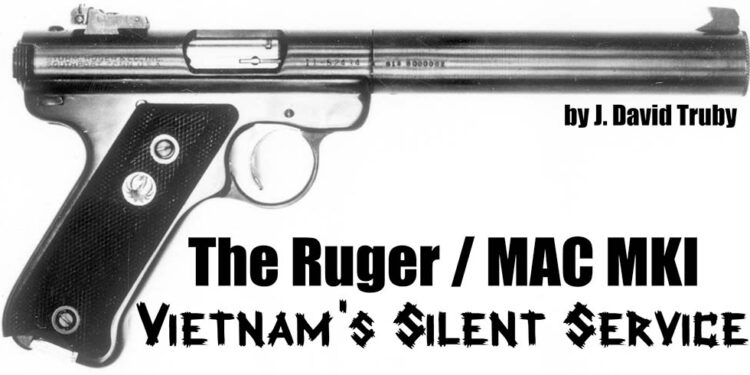By J. David Truby
The Vietnam War, plus the rise of coordinated and connected international terrorism in the 1960s and ’70s, along with films and TV shows glamorizing counter terrorists, spooks, spies, and warriors brought firearms sound suppressors to the attention of the vast media audience. In the real world of hushed killing, the design emphasis of the era was the .22 rimfire pistol.
In addition to being a highly controversial war, the Vietnam conflict was also a test lab for myriad ordnance experimentation, some bizarre, some lethally effective. The Ruger/MAC MKI suppressed pistol was among the latter.
An old favorite among target shooters, hunters and plinkers, the standard Ruger MKI was modified, a sound suppressor was added and the pistol went off to war with Army Special Forces, Navy SEALS, plus the CIA and DEA.
Former Special Forces NCO Fred Miller used the weapon extensively during his two tours in Southeast Asia. He told me, “Our units used the MkI for all sorts of sneaky ops, from dumping guards to out and out assassinations. On one cross-the-fence LRRP mission into (forbidden at the time) Cambodia we used MkI pistols for fresh food when our rations gave out…hunting in the bad guys’ back yard without letting them hear the shooting.”
Developed to replace that aging WWII vet Hi Standard HD pistol as a suppressed small caliber special mission weapon, the Ruger/MAC MkI was developed in the middle ’60s for military testing and combat use.

According to a specification sheet from field tests at Ft. Bragg in 1966, “The RUGER/MAC MkI is an excellent close-range Counter-Insurgency weapon with a very high degree of inherent accuracy and an unusually effective integral suppressor. This pistol was selected first because of the inherent superiority of its basic design system.”
In addition to the Ft. Bragg trials, the MkI was tested by the military at Aberdeen Proving Ground, Rock Island Arsenal, Eglin AFB, Ft. Benning, and by U.S. Navy SEAL units at Coronado. The CIA also evaluated the weapon at its covert facility near Camp Perry.
According to the report from the U.S. Army’s Marksmanship Unit, the suppressed pistols were also tested with telescopic sights. Their evaluation noted, “…with the telescope sight, great advantage is added to field versatility…giving the unit mini-sniper capability.” This paralleled the comments of ordnance expert C.E. Harris who tested the MkI for The National Rifle Association. Harris wrote, “In the field, the ‘scoped Ruger performs more like a rifle than a pistol. It is exceedingly accurate when fired from a supported position.”
Ruger introduced its MkI target model pistol, equipped with a Micro-adjustable sight and a 7-inch tapered barrel, in 1950 to sell for a modest $57.50. The new pistol had a 14-inch twist barrel rather than the one-in-16 of the standard model. According to Ruger, the faster twist provided better accuracy.
The bull-barrel model was produced in 1964 and was the weapon used in the suppressor developmental program. Although the American military bought thousands of the Ruger pistols, until the late Mitchell WerBell III entered the story none had ever been successfully sound suppressed. Working within a design dictate that the suppressor must fit within the parameters of the original pistol’s bull-barrel diameter configuration, WerBell and Gordon Ingram, his resident engineering genius at Military Armament Corporation (MAC), came up with the Ruger/MAC MkI.
Their design is such that the suppressed version looks exactly like the standard bull-barrel MkI built by Ruger. WerBell, a colorful ex-OSS and CIA operative, showed me the prototype MkI at his Powder Springs, Georgia plant in 1971, saying, “Our MkI looks just like the regular bull barrel pistol and doesn’t call attention to itself…ideal criterion for its covert role.”
The overall length of the MkI is 11.6 inches, with a widest measurement of 1.1 inches at the receiver. The barrel length is 6.25 inches total, with the integral suppressor at 5.6 inches. The internal suppressor contained a series of stainless steel screening discs, although later production models used centered metal inserts that improved the unit’s life and efficiency. WerBell’s Ruger/MAC MkI weighed a hefty 41 ounces, yet was very well balanced and handled easily. The majority of the design engineering was the work of Gordon Ingram.
The pistol’s sights are adjustable, as each click of the screw moves the impact of the bullet 3/4 inch at 25 meters. Commenting on the accuracy, ordnance consultant and former MAC historian Donald G. Thomas praised the basic design. He told me, “The sights were critically designed for match-accuracy, yet tough enough for combat operations. It’s a great marriage that meant a lot to the men who used the weapon in the field.”
One satisfied user of the suppressed MkI was a Special Forces sergeant who also worked for the CIA during his three tours between 1968 and 1973. He told me, “It was as accurate a pistol as I’ve ever used, which is damned important when you’re using a small caliber weapon for some of our missions. The muzzle noise from the weapon was nil…the bullet crack was never a real problem in any of my operations.”
These missions included guard dog suppression, suppression of personnel during prisoner snatches, and, assassination of target-specific military and political cadre.
Another retired special operations professional, a Korean War vet who landed at Inchon two days ahead of the main invasion (if that gives you some idea of his value, experience and abilities), carried a Ruger/MAC MkI while working in Cambodia in 1969 as a “paid civilian consultant.” Commenting on his MkI, he told me, “I put a telescope on it when I was out in the woods and it was the equal of, and as useful as, the silenced .22 rifles we had…those little Remington 66s. I used that pistol on targets up to 40 meters with very satisfactory results.” Did he consider the suppressor to be effective? “Well, you could say that I’d bet my life on it.”
Another veteran who ran covert operations, including portions of the famed Phoenix program, employed several professional shooters, and among the favored weapons in their toolbox was the Ruger/MAC MkI. Speaking of his former employees, this Special Forces vet acknowledged, “We did some political hits, whacking doubles, couriers, VC tax collectors, and things like that. My guys put their lives on that MkI, because most of those assignments had to be quiet, like in urban areas. Damn fine weapon, that MkI.”
He legally acquired a civilian MkI several years ago for old times sake for quiet, fun plinking, saying, “About the most lethal thing I do with that fun gun is drop the damned squirrels that dig up my wife’s bulbs in the yard. That suppressed pistol loaded with standard velocity ammo is sweet for hitting the pests without scaring my neighbors. I live in the suburbs and have that fine corporate image I gotta protect, you know.”
In 1985, I tested two MkIs, one with the original MAC suppressor unit that had been opened, repacked and replaced as new, and one with a unit designed by noted suppressor savant, Dr. Philip Dater, for his Automatic Weapons Company. I had three observers behind cover 150 feet from the firing line. At that range, none of the men heard any noise from the muzzle of either weapon, reporting only the hiss of the rounds passing overhead.
When I moved to within 50 feet, they reported a sound like that of a cap pistol from the MAC suppressor and a noticeably quieter signature from the Dater unit. At 25 feet, all three noted the report of both weapons, saying it was like that of a pellet gun for the MAC and like a muted hand-slap for the Dater gun. In more scientific and lab-measured testing, the AWC gun measured between 6 and 8 dB less sound than the original WerBell/Ingram design.
The major drawback of the original MAC suppressor was that its useful life was only 400 to 500 rounds before it began to lose its muffling abilities. As the units were sealed and unable to be repacked easily, the entire weapon was simply destroyed after the suppressor’s quieting abilities died. They were considered as field disposable.
Don Thomas told me that the units were cheaper to produce sealed and that the government wanted them that way. For civilian shooter and collector purchase, with the $200 transfer tax, there had to be a better way. That is how Dr. Phil Dater got into the business. He had one of the original Ruger/MAC MkI units and was not about to toss it out, put up with the hassle of paperwork and spent money to rebuild the suppressor.
Phil explained, “I tore it apart rather harshly, I fear, then rebuilt the unit internally and added some improvements of my own including a removable end cap. Now, I had something I could sell to the civilian market. I called my improved version the RST.”
The Dater unit replaced the standard MAC discs and wipe of the original unit with a special copper screening design. It was a major improvement. Phil laughed when he showed me that “special” high tech copper screening all those years ago. It was made from rolled and twisted strands of ChoreBoy sponges. Ever modest, Phil Dater said simply at the time, “I have the advantage of a lot of improved technology that Mitch didn’t have back in the ’60s when he pioneered that generation of sound suppressors.”
Within a short time, Ruger came out with their MkII pistol to replace the old original. Phil Dater’s modifications and addition of his improved Mk2 suppressor to this new Ruger pistol quickly became one of his most popular products for law enforcement and for civilian collector use.
We were then in the generation of that era’s can makers, e.g., Dater, Ciener, Knight, Walsh, et al, and their high design work. Indeed, the old Ruger MkI itself has been superseded by the MkII, which had its own generation of suppressor designs from those gentlemen previously mentioned.
The last time I saw that old veteran of special missions, the Ruger/MAC Mk1, was while I was on assignment in Central America in 1986. I met one of that generation’s young poop ‘n snoop kids who had a vintage Ruger/MAC Mk1 as part of his kit.
I asked him how he liked the weapon. He smiled and said he hadn’t used it in the field for real, only on the range at their small camp near San Pedro Sula. He added, “But, my dad used one when he was in SF in Vietnam in 1970/71 and told me great stories about it.”
In its service, the Ruger/MAC Mk1 has proved that a good bit of silence will go a long way, even if it has museum status today.
| This article first appeared in Small Arms Review V8N8 (May 2005) |











